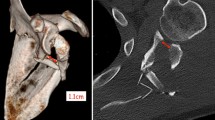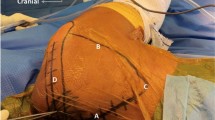Abstract
Background
Scapula fractures occur in the setting of high-energy trauma. Operative treatment of complex intra-articular scapular fractures can result in adequate surgical and functional outcomes.
Materials and methods
Twenty-seven patients with complex, displaced intra-articular scapular fractures with or without involvement of the scapular body, were treated operatively in a single trauma center between 2010 and 2021. Associated injuries such as ipsilateral upper limb fractures and nerve injuries were identified in the majority of the patients. Fixation with anatomical medial and lateral border precontoured plates was utilized following posterior modified Judet approach or/and anterior deltopectoral approach. Functional outcome was assessed using the Oxford Shoulder Score and detailed shoulder range of motion and return to work/activities data were obtained.
Results
At a mean follow-up of 69 months (range 4–135 months), individual functional outcomes for 25 of the 27 patients revealed a mean Oxford Shoulder Score of 33 (69%), mean active flexion of 120 degrees, active abduction of 110 degrees, mean active external rotation of 35 degrees and mean internal rotation to the level of T5. All patients were pain-free at the latest follow-up, and 23 of 25 had returned to their preinjury occupation and activities.
Conclusion
Operative treatment for these complex injuries is a viable option at centers equipped to handle critically ill patients and can result in satisfactory range of motion and functional score measurements along with a relatively low number of complications.


Similar content being viewed by others
References
Hardegger FH, Simpson LA, Weber BG (1984) The operative treatment of scapular fractures. J Bone Joint Surg Br 66:725–731
Ideberg R, Grevsten S, Larsson S (1995) Epidemiology of scapular fractures. Incidence and classification of 338 fractures. Acta Orthop Scand 66:395–397
McGahan JP, Rab GT, Dublin A (1980) Fractures of the scapula. J Trauma 20:880–883
Goss TP (1992) Fractures of the glenoid cavity. J Bone Joint Surg Am 74:299–305
Veysi VT, Mittal R, Agarwal S, Dosani A, Giannoudis PV (2003) Multiple trauma and scapula fractures: so what? J Trauma 55:1145–1147
Tadros AMA, Lunsjo K, Czechowski J, Abu-Zidan FM (2007) Multiple-region scapular fractures had more severe chest injury than single-region fractures: a prospective study of 107 blunt trauma patients. J Trauma 63:889–893
Weening B, Walton C, Cole PA, Alanezi K, Hanson BP, Bhandari M (2005) Lower mortality in patients with scapular fractures. J Trauma 59:1477–1481
Coimbra R, Conroy C, Tominaga GT, Bansal V, Schwartz A (2010) Causes of scapula fractures differ from other shoulder injuries in occupants seriously injured during motor vehicle crashes. Injury 41:151–155
Wijdicks CA, Armitage BM, Anavian J, Schroder LK, Cole PA (2009) Vulnerable neurovasculature with a posterior approach to the scapula. Clin Orthop 467:2011–2017
Obremskey WT, Lyman JR (2004) A modified judet approach to the scapula. J Orthop Trauma 18:696–699
Nork SE, Barei DP, Gardner MJ, Schildhauer TA, Mayo KA, Benirschke SK (2008) Surgical exposure and fixation of displaced type IV, V, and VI glenoid fractures. J Orthop Trauma 22:487–493
Jones CB, Cornelius JP, Sietsema DL, Ringler JR, Endres TJ (2009) Modified Judet approach and minifragment fixation of scapular body and glenoid neck fractures. J Orthop Trauma 23:558–564
Anavian J, Gauger EM, Schroder LK, Wijdicks CA, Cole PA (2012) Surgical and functional outcomes after operative management of complex and displaced intra-articular glenoid fractures. J Bone Joint Surg Am 94:645–653
Cole PA, Gauger EM, Herrera DA, Anavian J, Tarkin IS (2012) Radiographic follow-up of 84 operatively treated scapula neck and body fractures. Injury 43:327–333
Gauger EM, Cole PA (2011) Surgical technique: a minimally invasive approach to scapula neck and body fractures. Clin Orthop 469:3390–3399
Cole PA, Gauger EM, Schroder LK (2012) Management of scapular fractures. J Am Acad Orthop Surg 20:130–141
Aston JWJ, Gregory CF (1973) Dislocation of the shoulder with significant fracture of the glenoid. J Bone Joint Surg Am 55:1531–1533
Guttentag IJ, Rechtine GR (1988) Fractures of the scapula. A review of the literature. Orthop Rev 17:147–158
Schandelmaier P, Blauth M, Schneider C, Krettek C (2002) Fractures of the glenoid treated by operation. A 5- to 23-year follow-up of 22 cases. J Bone Joint Surg Br 84:173–177
Leung KS, Lam TP, Poon KM (1993) Operative treatment of displaced intra-articular glenoid fractures. Injury 24:324–328
Kavanagh BF, Bradway JK, Cofield RH (1993) Open reduction and internal fixation of displaced intra-articular fractures of the glenoid fossa. J Bone Joint Surg Am 75:479–484
Adam FF (2002) Surgical treatment of displaced fractures of the glenoid cavity. Int Orthop 26:150–153
Mayo KA, Benirschke SK, Mast JW (1998) Displaced fractures of the glenoid fossa. Results of open reduction and internal fixation. Clin Orthop 347:122–130
Dawson J, Fitzpatrick R, Carr A (1996) Questionnaire on the perceptions of patients about shoulder surgery. J Bone Joint Surg Br 78:593–600
Hunsaker FG, Cioffi DA, Amadio PC, Wright JG, Caughlin B (2002) The American academy of orthopaedic surgeons outcomes instruments: normative values from the general population. J Bone Joint Surg Am 84:208–215
Wilber MC, Evans EB (1977) Fractures of the scapula. An analysis of forty cases and a review of the literature. J Bone Joint Surg Am 59:358–362
Aulicino PL, Reinert C, Kornberg M, Williamson S (1986) Displaced intra-articular glenoid fractures treated by open reduction and internal fixation. J Trauma 26:1137–1141
Rowe CR (1963) Fractures of the scapula. Surg Clin North Am 43:1565–1571
Constant CR, Murley AH (1987) A clinical method of functional assessment of the shoulder. Clin Orthop 214:160–164
Gill TK, Shanahan EM, Tucker GR, Buchbinder R, Hill CL (2020) Shoulder range of movement in the general population: age and gender stratified normative data using a community-based cohort. BMC Musculoskelet Disord 21:676
Funding
No benefits have been or will be received from a commercial party related directly or indirectly to the subject matter of this article.
Author information
Authors and Affiliations
Corresponding author
Ethics declarations
Conflict of interest
The authors declare that they have no competing interests.
Ethical approval
All of the procedures performed in studies involving human participants were in accordance with the ethical standards of the institutional and/or national research committee and with the 1964 Helsinki Declaration and its later amendments or comparable ethical standards.
Informed consent
Informed consent was obtained from all individual participants included in the study
Additional information
Publisher's Note
Springer Nature remains neutral with regard to jurisdictional claims in published maps and institutional affiliations.
Rights and permissions
About this article
Cite this article
Dimopoulos, L., Antoniadou, T., Desai, C. et al. Operative treatment of complex intra-articular scapular fractures: long-term functional outcomes in a single-center study. Eur J Orthop Surg Traumatol 33, 1621–1627 (2023). https://doi.org/10.1007/s00590-022-03323-x
Received:
Accepted:
Published:
Issue Date:
DOI: https://doi.org/10.1007/s00590-022-03323-x




